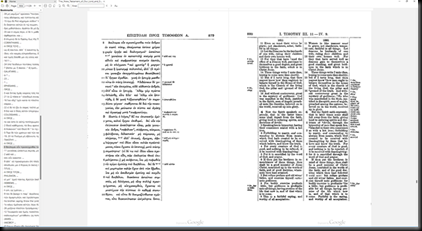A Stephanus Greek, KJV, and ERV interlinear
This site now has a copy of The Parallel New Testament Greek and English from Oxford University Press, 1896. This text contains the Authorized Version (KJV), the English Revised Version, and a Greek text based the third edition of Stephanus published in 1550. The two streams of Greek texts are the received stream via Erasumus/Beza/Elzevir/Stephanus/Scrivener and the critical stream via Westcott/Hort/Tischendorf. Texts within the same stream can differ, and other than Erasumus, I prefer the Stephanus. The reason is that Erasmus’ text lacked verse numbers and Stephanus added them. Stephanus is thus the oldest received text stream associated with the time of the publication of the KJV. Scrivener was late to the game, and while it is nice to have a newer Greek text in that stream, any new Greek text copywritten after the arrival of Tischendorf puts me off.
This is the Textus Receptus, also called the received text.
There are some differences in received text versions, some which are significant such as without where with should be and vice versa. [1]
Sumatra PDF reader (Local mirror of 3.5.2 64-bit) works wonderfully for viewing these kind of books. The following screenshot was taken with “Book View” on, and “Scroll Pages Continuously” activated. Librera is excellent for Android.
1. “Which Edition of the Received Text Should We Use?” Accessed July 12, 2025. https://www.wayoflife.org/reports/which_edition_of_received_text_should_we_use.html.


